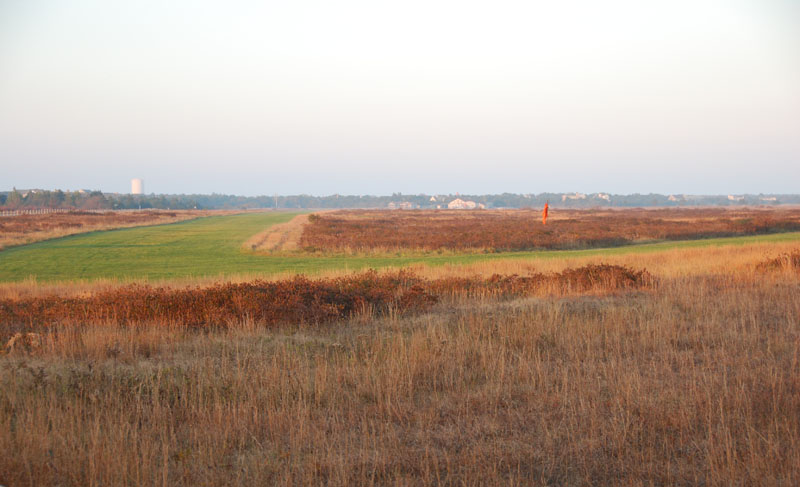
Katama Airpark
Saving the Katama heathlands – a complex, collaborative conservation success story
During the Second World War, the U.S. military took by eminent domain one square mile of the State Forest in the center of the Island to establish a naval air station. They also made use of a small grass-strip airfield at Katama located near a gunnery practice area established at South Beach. The former pastureland had been used continuously since 1924 as an airfield. In 1944 the airfield was purchased by Steven Gentle, who ran it as the Katama Airpark.
In 1979, the Vineyard Conservation Society successfully partnered with the town and state to conserve the 220-acre Katama Farm. The next year, Edgartown leader Bob Morgan approached the committee assembled to work on the Katama project to direct its attention to the abutting Katama Airfield, a 190-acre parcel containing unique sandplain grassland habitat, important to more than a dozen rare plant and animal species. Ecologists referred to the Katama habitat as “something of a living museum; a kind of Galapagos.”
The shared goal of VCS and colleagues was to protect the wildlife habitat, fend off the potential development of 120 units of housing allowable under existing zoning, and create a block of contiguous public open space including Katama Farm and the state-owned South Beach.
In the public eye, the initiative became a “Race to Save the Coastal Heathlands.”
In 1981, VCS secured a 12 month option from the Gentle family to purchase the airfield for $1 million. The option expired before it could be exercised, but momentum for conservation was building.
In September 1982, a report on the ecological significance of the airpark was prepared by the Natural Heritage Program of the state Division of Fisheries and Wildlife. Based on its findings, the Nature Conservancy (TNC) became a partner in the effort in 1983. TNC agreed to facilitate the purchase negotiations and take title, with an eye to eventually transferring ownership to the town, while retaining a management right.
But the goalposts continued to move as land prices on the Vineyard spiraled upward and the price for the Gentle family interest went to $1.575 million. The purchase price for two other smaller interests totaling 68 acres owned by the Nickersons and Atwoods added an additional $1.8835 million, for a total project cost of $2.8835 million plus soft costs.
The conservation team prepared an application in partnership with the Town of Edgartown for a grant from the state Self-Help Program, funded through the Division of Conservation Services of the Executive Office of Environmental Affairs (EOEA). The program required financial “match” from town voters of one-third the grant.
In early 1984, EOEA awarded the town a $1.5 million grant towards purchase of 190-acres of airpark land, including 128 acres constituting the airfield itself. But the conservation team needed to return to EOEA for additional funds, eventually securing the largest total Self Help grant to date, totaling 1.85 million. The town’s match was $625,000.
In January of 1985, TNC put $1.575 million into an escrow account to secure the 123-acre Gentle parcel, using a combination of grants and loans from the R.K. Mellon Foundation and the Goodhill Foundation.
Still, the gap needed to be covered by private fundraising was wide, some $408,500.
In August of 1985, VCS presented to TNC a $20,000 check on behalf of the Katama working committee, and in November of 1986 presented an additional $60,000. During that time, an aggressive campaign aimed at abutters and pilots who use the airfield pushed the project over the top.
In the final arrangement, TNC conveyed the Gentle parcel to the town, with some cost recovery from the Self-Help dollars awarded to the town. The town then granted TNC a conservation restriction (CR) on the parcel. The town also purchased outright the Nickerson and Atwood parcels, totaling 68 acres. The Katama Plains Conservation Area (KPCA), totaling 190 acres, was officially dedicated in 1987.
Later that year, TNC prepared the first of the Stewardship Management reports for the airfield, including the recommendation that prescribed use of fire be used to maintain the open character of the habitat.
